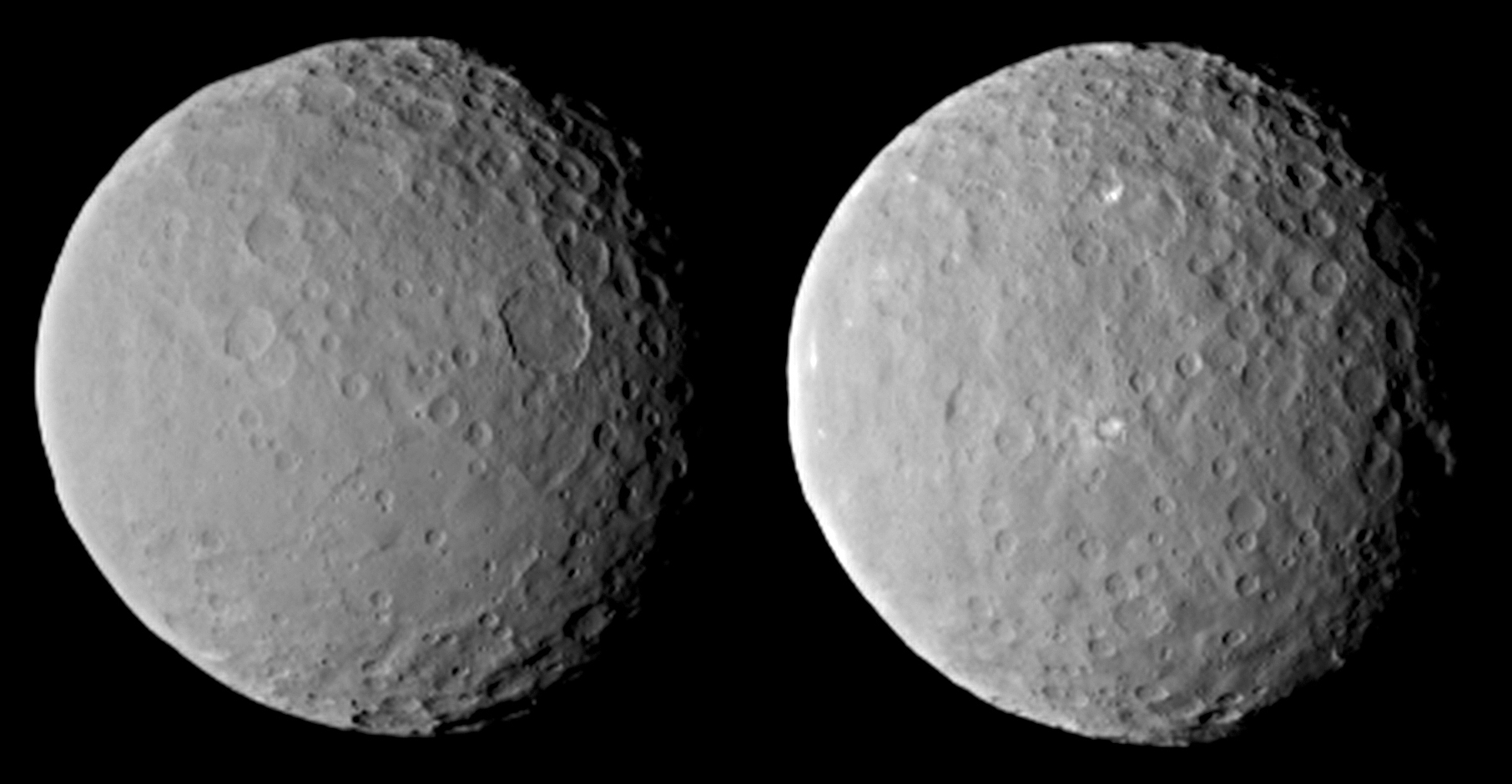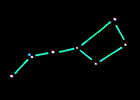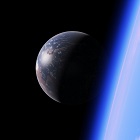|
First Hi-Res Photos of Ceres Are Here!
|
|
| Handbanana | Date: Thursday, 26.02.2015, 02:39 | Message # 1 |
 Astronaut
Group: Users
 United States
United States
Messages: 70
Status: Offline
| After eight years, dawn has finally arrived at Ceres:


Tonight... you.
|
| |
| |
| FastFourierTransform | Date: Thursday, 26.02.2015, 08:16 | Message # 2 |
 Pioneer
Group: Local Moderators
 Spain
Spain
Messages: 542
Status: Offline
| The mysterius Bright Spot on Ceres. It looks like a city 

|
| |
| |
| Fireinthehole | Date: Thursday, 26.02.2015, 08:52 | Message # 3 |
 Pioneer
Group: Translators
 Sweden
Sweden
Messages: 356
Status: Offline
| Looks like a random selena world from SE 
Love SpaceEngine!
|
| |
| |
| apenpaap | Date: Thursday, 26.02.2015, 10:58 | Message # 4 |
 World Builder
Group: Users
 Antarctica
Antarctica
Messages: 1063
Status: Offline
| Our first look at a dwarf planet!
I wonder what the white spots are. Their sharp contrast with their surroundings reminds me a little of the monolith on Iapetus in 2001: A Space Odyssey (the book, not the film).
I occasionally stream at http://www.twitch.tv/magistermystax. Sometimes SE, sometimes other games.
|
| |
| |
| Thomas988 | Date: Thursday, 26.02.2015, 15:58 | Message # 5 |
 Space Pilot
Group: Users
 United States
United States
Messages: 125
Status: Offline
| Agh! That is so cool!
Recently I wrote a short essay (only a page long) on the recent Dawn happenings for civics class and I've been excited for the mission ever since. This is awesome stuff!
Get hyped for Pluto!
All you need in life are space games and typhlosions.
Edited by Thomas988 - Thursday, 26.02.2015, 15:58 |
| |
| |
| Fireinthehole | Date: Thursday, 26.02.2015, 19:07 | Message # 6 |
 Pioneer
Group: Translators
 Sweden
Sweden
Messages: 356
Status: Offline
| Quote Thomas988 (  ) Get hyped for Pluto!
Yeah I can't wait until we finally get to see what it looks like from up-close  Too bad New Horizons won't land on it though. Too bad New Horizons won't land on it though.
Love SpaceEngine!
|
| |
| |
| Jadestar | Date: Thursday, 26.02.2015, 20:56 | Message # 7 |
|
Astronaut
Group: Users
 United States
United States
Messages: 70
Status: Offline
| It would be awesome if that high albedo area is a massive exposed ice field! 
|
| |
| |
| Salvo | Date: Thursday, 26.02.2015, 20:57 | Message # 8 |
 Star Engineer
Group: Local Moderators
 Italy
Italy
Messages: 1400
Status: Offline
| Does it actually looks gray or it's just because of the Dawn's camera?
I guess those kind of planets should have a yellowish color like Pluto and Charon probably do 
The universe is not required to be in perfect harmony with human ambition.
CPU: Intel Core i7 4770 GPU: ASUS Radeon R9 270 RAM: 8 GBs
(still don't know why everyone is doing this...)
|
| |
| |
| FastFourierTransform | Date: Thursday, 26.02.2015, 22:45 | Message # 9 |
 Pioneer
Group: Local Moderators
 Spain
Spain
Messages: 542
Status: Offline
| Quote Salvo (  ) It would be awesome if that high albedo area is a massive exposed ice field!
I think is quite plausible. Maybe the impact that created that crater reached the subsurface ocean and the water freezed while exposed to the vacum of space, making a mirror in the base of the crater. I want to see what it is!!! 
What i found strange is the fact that when ceres rotates the bright spot looks equally bright, as if the angle of incidence of the sun dosen't make any difference, and that makes me feel like this is not just a mirror. You can see this with the hubble images taken a few months ago. the spot shines equally:

Since we are aproaching Ceres from the inner solar system, we have only seen the day-side of the dwarf planet, but immagine that this week watching the other side we discover that the spot is also bright at night!! that woould be terrifying xD and would make the reflection hypothesis erroneus. Immagine that the spot is shinning because of his own emission. It would be awesome (as everything probably).
I have "taken some measurements" aproximating the shapes with Geogebra 

Knowing that Ceres has a diameter of 952,4 km we can figure out that the diameter of the crater is aproximately 102,2 km, the bright spot appears to be like 14,5 km in size (like a big city), but I think that the size is just an illusion due to the brighness of the location. Maybe the bright zone gets smaller when the instruments resolve the point-like source. The second bright spot is near the first one: Just 13 km away 
Maybe with this rought measurements we can set the stage for our imagination.
Edited by FastFourierTransform - Thursday, 26.02.2015, 22:48 |
| |
| |
| Niako | Date: Friday, 27.02.2015, 16:50 | Message # 10 |
 Space Tourist
Group: Users
 Spain
Spain
Messages: 21
Status: Offline
| Are photos taked in color or in black and white? Because that spot could be a volcano or something like that!
|
| |
| |
| pzampella | Date: Sunday, 01.03.2015, 15:27 | Message # 11 |
 Space Pilot
Group: Users
 Venezuela
Venezuela
Messages: 115
Status: Offline
| Niako, given the size of the body, it can't have active volcanoes. To explain it, just think that as a body is smaller, it cools faster (unless it is heated by a massive neighbor's gravity, like Io and Jupiter). Mars for example, is practically frozen while Earth still keeps it heat and volcano activity.
Ceres is completely alone, so it is frozen and have no volcanoes. Therefore, the explanation must be a lot more interesting!
|
| |
| |
| SpaceEngineer | Date: Sunday, 01.03.2015, 18:46 | Message # 12 |
 Author of Space Engine
Group: Administrators
 Russian Federation
Russian Federation
Messages: 4800
Status: Offline
| Quote FastFourierTransform (  ) the bright spot appears to be like 14,5 km in size (like a big city), but I think that the size is just an illusion due to the brighness of the location.
Yes it is much smaller in reality. On this image it is overexposed. Look at more older images from Dawn.
Quote pzampella (  ) Niako, given the size of the body, it can't have active volcanoes.
It could have a cryovolcanoes. Water vapour emission from Ceres was detected a year ago.

|
| |
| |
| SpaceEngineer | Date: Monday, 02.03.2015, 20:09 | Message # 13 |
 Author of Space Engine
Group: Administrators
 Russian Federation
Russian Federation
Messages: 4800
Status: Offline
| This is not a city lights 


|
| |
| |
| Watsisname | Date: Monday, 02.03.2015, 22:10 | Message # 14 |
 Galaxy Architect
Group: Global Moderators
 United States
United States
Messages: 2613
Status: Offline
| Dang, I was really hoping. 
More seriously, I wonder if studying how its brightness changes as a function of phase angle, relative to the surroundings, would be helpful in determining what substance it is. I'd suspect it would be different for ice than for light-colored rocky material.

|
| |
| |
| FastFourierTransform | Date: Monday, 02.03.2015, 22:54 | Message # 15 |
 Pioneer
Group: Local Moderators
 Spain
Spain
Messages: 542
Status: Offline
| Quote SpaceEngineer (  ) This is not a city lights sad
Quote SpaceEngineer (  ) Dang, I was really hoping. sad
hahahah. Well at least now we know it's from reflexion that the spot shines.
Since it doesn't change to much at different angles I think this has to be a complex surface with many contortions so that it reflects light equally in all directions.
I've picked one of the frames of that animated gif:

At the planet's terminator it shines amazingly!!! even at twilight it looks like a lighthouse  so this have to be a very reflective surface. so this have to be a very reflective surface.
I have one question:
If the bright spot shows overexposure to the camera then we can't determine the brightness of the surface until we resolve the dimensions of that small region right? So if the size of the shining area gets smaller, that means that it's brighter. How bright is by now, considering that it measures at max 14 km?
|
| |
| |